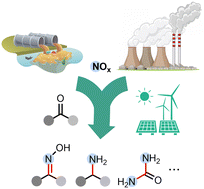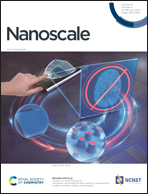Recent research progress on building C–N bonds via electrochemical NOx reduction
Abstract
The release of NOx species (such as nitrate, nitrite and nitric oxide) into water and the atmosphere due to human being's agricultural and industrial activities has caused a series of environmental problems, including accumulation of toxic pollutants that are dangerous to humans and animals, acid rain, the greenhouse effect and disturbance of the global nitrogen cycle balance. Electrosynthesis of organonitrogen compounds with NOx species as the nitrogen source offers a sustainable strategy to upgrade the waste NOx into value-added organic products under ambient conditions. The electrochemical reduction of NOx species can generate surface-adsorbed intermediates such as hydroxylamine, which are usually strong nucleophiles and can undergo nucleophilic attack to carbonyl groups to build C–N bonds and generate organonitrogen compounds such as amine, oxime, amide and amino acid. This mini-review summarizes the most recent progress in building C–N bonds via the in situ generation of nucleophilic intermediates from electrochemical NOx reduction, and highlights some important strategies in facilitating the reaction rates and selectivities towards the C–N coupling products. In particular, the preparation of high-performance electrocatalysts (e.g., nano-/atomic-scale catalysts, single-atom catalysts, alloy catalysts), selection of nucleophilic intermediates, novel design of reactors and understanding the surface adsorption process are highlighted. A few key challenges and knowledge gaps are discussed, and some promising research directions are also proposed for future advances in electrochemical C–N coupling.

- This article is part of the themed collections: Recent Review Articles and Nanoscale 2024 Emerging Investigators


 Please wait while we load your content...
Please wait while we load your content...